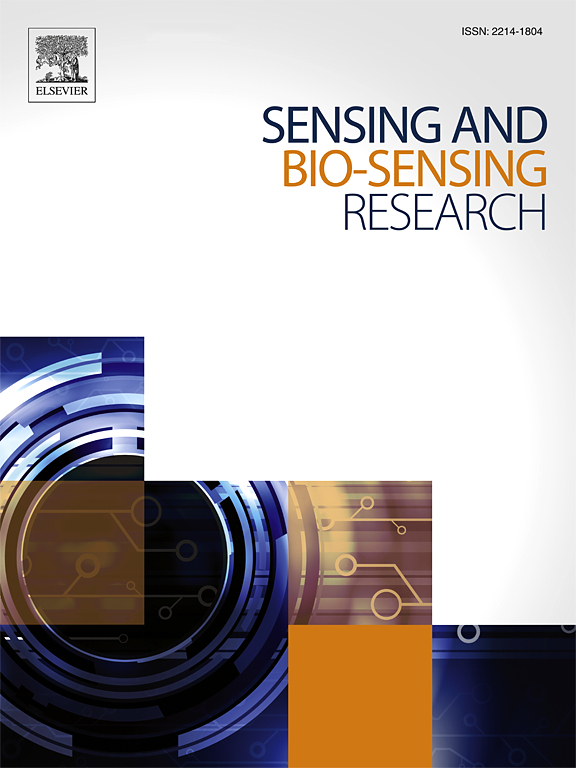紫竹合成铁纳米颗粒去除酚红的生物学特性研究
IF 4.9
Q1 CHEMISTRY, ANALYTICAL
引用次数: 0
摘要
在这项研究中,生物合成氧化铁纳米颗粒(FeNPs)是绿色合成的,利用富含多酚的海参提取物。通过对黄酮类化合物、单宁类化合物、甾体类化合物、皂苷类化合物、多酚类化合物等次生代谢产物的筛选和GC-MS分析,确定了黄酮类化合物中主要的12种生物活性化合物,这些活性化合物负责铁还原和NP稳定。采用UV-Vis、FTIR、SEM、TEM、XRD、EDX、XPS和EIS等手段对棕褐色FeNPs进行了表征。扫描电镜显示含有纳米级结构域(77.78 ~ 121.38 nm)的微尺度聚集体。XRD证实纳米晶Fe₃O₄尖晶石结构[(220)、(311)、(400)、(511)、(440)面]。EDX以Fe/O为主。FTIR显示Fe3+螯合基团(-OH, -S =O)。EIS显示电荷转移增强(C <;sub>dl</sub≥0.146,裸GCE为0.034)。FeNPs具有显著的抗氧化活性(DPPH/ABTS),乙醇提取物具有快速清除能力(866.5±3.5 at 1 min)。总多酚含量为212.47±7.07 mg GAE/g。苯酚红的染料吸附达到峰值(pH为8时为94.9 mg/g),遵循自发/放热热力学。当初始染料浓度从5 mg/L增加到40 mg/L时,A. marina-FeNPs对苯酚红(PR)的去除率从95.6%下降到54.6%。温度研究(25°C、35°C、45°C)表明,温度升高会显著降低PR的吸附效率。同样,在固定条件下(染料浓度为5 mg/L,吸附剂用量为5 g/L, pH为6.9),亚甲基蓝(MB)的去除率也随着温度的升高而下降。热力学参数(ΔG°,ΔH°,ΔS°)证实了两种染料的吸附过程均为自发和放热的。EDX分析表明,该玻璃制品含铁76.56%,氧17.09%,而合成的氧化铁纳米颗粒含铁46.79%,氧36.47%,其他元素(包括碳和硫)15.96%。这些多功能FeNPs在环境修复和生物医学应用方面显示出前景。本文章由计算机程序翻译,如有差异,请以英文原文为准。
Biological characterization of synthesized iron nanoparticles (FeNPs) from Avicennia marina for phenol red removal
In this study, biosynthesized Iron oxide nanoparticles (FeNPs) were green-synthesized using polyphenol-rich Avicennia marina extract. Phytochemical screening of secondary metabolites such as flavonoids, tannins, steroids, saponins, polyphenols and GC–MS identified major twelve bioactive compounds present in (responsible for Fe3+ reduction and NP stabilization. The brown FeNPs were characterized by UV–Vis, FTIR, SEM, TEM, XRD, EDX, XPS, and EIS. SEM revealed microscale aggregates containing nanoscale domains (77.78–121.38 nm). XRD confirmed nanocrystalline Fe₃O₄ spinel structure [(220), (311), (400), (511), (440) planes]. EDX showed dominant Fe/O composition. FTIR indicated Fe3+-chelating groups (–OH, –S=O). EIS demonstrated enhanced charge transfer (C < sub>dl</sub≥ 0.146 vs. 0.034 for bare GCE). FeNPs exhibited significant antioxidant activity (DPPH/ABTS), with ethanol extract showing rapid scavenging (866.5 ± 3.5 at 1 min). Total polyphenols reached 212.47 ± 7.07 mg GAE/g extract. Dye adsorption peaked for phenol red (94.9 mg/g at pH 8), following spontaneous/exothermic thermodynamics. The removal efficiency of phenol red (PR) dye by A. marina-FeNPs decreased from 95.6 % to 54.6 % as the initial dye concentration increased from 5 mg/L to 40 mg/L. Temperature studies (25 °C, 35 °C, 45 °C) revealed that increasing temperature significantly decreased PR adsorption efficiency. Similarly, under fixed conditions (5 mg/L dye concentration, 5 g/L adsorbent dosage, pH 6.9), methylene blue (MB) removal efficiency also declined with rising temperature. Thermodynamic parameters (ΔG°, ΔH°, ΔS°) confirmed the adsorption process for both dyes was spontaneous and exothermic. EDX analysis showed the glassware contained 76.56 % iron and 17.09 % oxygen, while the synthesized iron oxide nanoparticles consisted of 46.79 % iron, 36.47 % oxygen, and 15.96 % other elements (including carbon and sulfur). These multifunctional FeNPs show promise for environmental remediation and biomedical applications.
求助全文
通过发布文献求助,成功后即可免费获取论文全文。
去求助
来源期刊

Sensing and Bio-Sensing Research
Engineering-Electrical and Electronic Engineering
CiteScore
10.70
自引率
3.80%
发文量
68
审稿时长
87 days
期刊介绍:
Sensing and Bio-Sensing Research is an open access journal dedicated to the research, design, development, and application of bio-sensing and sensing technologies. The editors will accept research papers, reviews, field trials, and validation studies that are of significant relevance. These submissions should describe new concepts, enhance understanding of the field, or offer insights into the practical application, manufacturing, and commercialization of bio-sensing and sensing technologies.
The journal covers a wide range of topics, including sensing principles and mechanisms, new materials development for transducers and recognition components, fabrication technology, and various types of sensors such as optical, electrochemical, mass-sensitive, gas, biosensors, and more. It also includes environmental, process control, and biomedical applications, signal processing, chemometrics, optoelectronic, mechanical, thermal, and magnetic sensors, as well as interface electronics. Additionally, it covers sensor systems and applications, µTAS (Micro Total Analysis Systems), development of solid-state devices for transducing physical signals, and analytical devices incorporating biological materials.
 求助内容:
求助内容: 应助结果提醒方式:
应助结果提醒方式:


